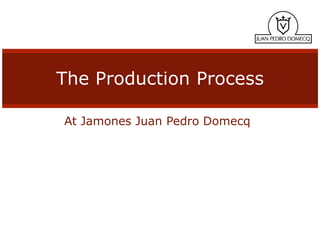
Iberico Ham: The production process at Juan Pedro Domecq
- 1. The Production Process At Jamones Juan Pedro Domecq
- 2. Introduction The pigs at Juan Pedro Domecq are bred at the Dehesa Lo Álvaro, coming always from the same mothers and fathers in order to ensure our motto: high quality and product homogeneity. Our norm is to let the pigs free roam in extensive areas of the Dehesa where there is no more than 1pig per hectare. Prior to sending any pig to the adjacent dehesas in which they spend the Montaneras (acorn seasons), in order to ensure each pig gets their fair share of acorns, our employees value the amount of pigs each enclosure can hold. From here onwards the process goes through the following phases: 1. Exiting the Montanera 2. Slaughterhouse 3. Salting and stabilizing process 4. Drying by natural process 5. Curing process 6. Dispatch
- 3. 1. Exiting the Montanera It takes place at least 120 days after the start of the acorn season («Montanera») The exact day is determined by the number of pigs which have achieved the required weight Only pigs weighing 160 kg or more and are sent to the slaughterhouse
- 4. 2. Slaughterhouse Once in the slaughterhouse and always under control of the company’s personnel the slaughter is started. Each piece is individually tracked and sealed, guaranteeing the provenance of each one. Once the quartering is done the pieces are set in cold store in order to take their temperature down and thus avoid bacterial formations. The day after, once their temperature is lower than 2-3ºC, the pieces are given form eliminating the excess fat, lean and skin. This process is developed by 4 workers (each year the same 4), to ensure, once more, the product homogeneity. Once shaped, the pieces are put back in the cold store for an additional day, until they start the salting and stabilizing process.
- 5. 3. Salting and Stabilizing process At Juan Pedro Domecq the salting and stabilizing process is outsourced to a factory specifically dedicated to this activity; in order, once more, to ensure the product homogeneity. Once the pieces get to the factory, the first step is temperature and weight control. The weight of each piece determines the amount of time it has to spend in contact with salt, thus being a key information to carry on adequately. Once classified, they are taken to the salting vaults, were they are sorted according to weight and in such a way to ensure each piece is directly and completely in contact with salt. The temperature and humidity level of the salting vaults is under strict control. Each piece will spend between 1 and 1.5 days per kg of initial weight in these conditions. Once the salting is completed the remaining external salt is washed away with warm water and the pieces are taken to the stabilizing vaults. This process implies the diffusion of salt throughout the piece and the reduction of internal humidity in each piece. Temperature and humidity are again under strict control. Temperature is sequentially increased from initial 0-3ºC to outside temperature of around 12-14ºC. This process takes between 80 and 90 days. Once they come out of these vaults, the quantity of useful water and the salt concentration in the piece are at such a level that they make impossible the proliferation of pathogenic microorganisms inside them. They are ready to move on to the next phase.
- 6. 4. Drying by natural process Once the pieces are perfectly stabilized and acclimatized, the Juan Pedro Domecq personnel checks each piece both to ascertain its origin and its state of preservation. Once checking is completed the pieces are transferred to the company’s premises at Jabugo. Once there, they are set in the natural drying vault, where the pieces are exposed to the temperature and winds of the mountains until the end of the following winter. The only control over temperature and humidity is achieved through the opening and closing of windows. This allows the reduction of the influence of excessive heat and humidity.
- 7. 5. Curing process Once the drying period is completed and always at the end of winter or start of spring the pieces are transferred to the cave. Here they will spend the remaining time until they are dispatched. The amount of time spend in the cave is never less than 24 months for a piece of ham. The pieces are not always located in the same spot within the cave, they are sequentially moved from the area further located from the dispatch area to the one closer to it; this ensures that the pieces receive the most homogeneous possible curing process. Humidity, which along with temperature is key during this process, is around 60-75% while temperature is around 12-18 ºC. Both conditions are more stable in the cave than in any of the previous phases. At this time the ham is following its ripening process, during which the sweating of the internal fats in the ham takes place more slowly, allowing the associated aromas (obtained thanks to the consumption of acorns) to remain inside thus giving the bellota ham its characteristic and unique aroma.
- 8. 6. Dispatch Before dispatching any of our hams the Master Carver ensures through touch that each piece is perfectly cured. Once the piece passes the “touch” test it is submitted to the «Cala» process. This process implies the insertion of an instrument named «Cala» (a sought of punch made from the shinbone of a cow) in 3 or 4 spots in the ham. These spots are chosen due to the concentration of aromas in each one, as the process is non other than inserting the instrument, taking it out and then smelling the aromas attached to it This is done to ensure that the aromas are the ones wished for and so that the ham is ready for consumption.
